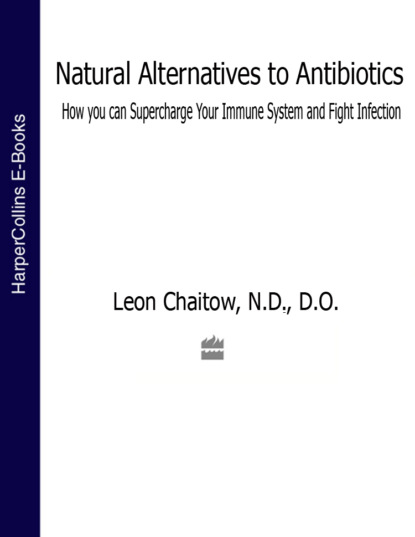По всем вопросам обращайтесь на: info@litportal.ru
(©) 2003-2024.
✖
Natural Alternatives to Antibiotics: How you can Supercharge Your Immune System and Fight Infection
Автор
Год написания книги
2019
Настройки чтения
Размер шрифта
Высота строк
Поля
assisting in the digestion and absorption of essential nutrients from food
destroying invading bacteria (note that not all strains of L. acidophilus can do this, however)
slowing down and controlling yeast invasions such as Candida albicans.
BIFIDOBACTERIUM LONGUM
This is a natural inhabitant of the human intestines and vagina. It is found in larger numbers in the large intestine than the small intestine. Together with other bifidobacteria, this is the dominant organism of breastfed infants (making up 99 percent of the microflora). In adolescence and adult life the bifidobacteria are still the dominant organism of the large intestine (when health is good). Among its main benefits are:
preventing colonization by hostile microorganisms by competing with them for attachment sites and nutrients
production of lactic and acetic acids, which inhibit invading bacteria
helping in weight gain in infants by retention of nitrogen
preventing harmful nitrites being formed from nitrates in the digestive tract
manufacturing B-vitamins
assisting in liver detoxification.
BIFIDOBACTERIUM INFANTIS
This is a natural inhabitant of the human infant’s digestive tract (as well as of the vagina, in small quantities). Its presence is far greater in the bowel of breastfed infants compared with bottle-fed infants. Among its main benefits are:
preventing colonization by hostile microorganisms by competing with them for attachment sites and nutrients
production of lactic and acetic acids, which inhibit invading bacteria
helping in weight gain in infants by retention of nitrogen
preventing harmful nitrites being formed from nitrates in the digestive tract
manufacturing B-vitamins.
LACTOBACILLUS BULGARICUS
This extremely useful friendly bacteria is not a resident of the human body, but a ‘transient’. Once it enters the body through food (yogurt, for example) it remains for several weeks before being passed, but while in the body it performs useful tasks. L. bulgaricus is a yogurt culture, as is the other main yogurt-making culture, Streptococcus thermophilus (see below), and is therefore found in some yogurts and cheeses if they have not been sterilized to kill their bacterial cultures to enhance shelf-life – after manufacture. It performs a number of useful roles, such as:
Some strains produce natural antibiotic substances.
Some strains have been shown to have anti-cancer properties.
They enhance the ability to digest milk and its products by producing the enzyme lactase, which is absent or deficient in almost half the adults on earth, and many children, especially if they are of Asian, African or Mediterranean descent.
Because they produce lactic acid (as do all bacteria with ‘lactobacillus’ as the first part of their name), they help to create an environment which encourages colonization by the bifidobacteria (they are therefore known as ‘bifidogenic’ bacteria) and by L. acidophilus, by helping to prevent colonization by other, undesirable microorganisms.
STREPTOCOCCUS THERMOPHILIC
This is a transient (non-resident) bacteria of the human intestine which together with L. bulgaricus (see above) is a yogurt culture, also found in some cheeses. It performs a number of useful roles, such as:
Some strains produce natural antibiotic substances.
They enhance the ability to digest milk and its products, by producing the enzyme lactase.
They produce lactic acid, thereby helping to create an environment which encourages colonization by the bifidobacteria and by L. acidophilus, and which discourages colonization by other, undesirable microorganisms.
STREPTOCOCCUS FAECIUM
This is a natural resident of the human intestine. It is found in human feces as well as on some plants and insects. Its characteristics include:
It is used as a part of the manufacture of cheeses (in some dairies, not all).
Its potential benefits to humans remain a possibility but not a certainty.
It manufactures lactic acid from carbohydrates and so enhances the environment for colonizing friendly bacteria.
STREPTOCOCCUS FAECALIS
This is a resident of the human intestine which is known as an enterococcus. It is found in feces, some insects and some plants. Its characteristics include:
the manufacture of lactic acid from carbohydrates, thereby enhancing the environment for colonizing friendly bacteria
the production of substances called amines, which can be toxic. Tyramine, for example, is associated with migraine headaches, and histamine with allergic and inflammatory reactions.
has been associated with urinary tract infections
overall there is little evidence that S. faecalis is beneficial for humans; on balance it would seem to have a harmful potential.
Some additional (usually useful) lactobacilli found in the digestive tract include:
L. casei – a transient bacteria of the intestine, found in cheese and other dairy products; manufactures lactic acid, so reducing the chances of invading bacteria being able to colonize the area
L. plantarum – a transient bacteria of the intestine, found in dairy products, sauerkraut, pickled vegetables; manufactures lactic acid
L. brevis – a transient bacteria of the intestine, found in dairy products (especially kefir, a fermented milk drink); manufactures lactic acid
L. salivarius – a natural resident of the mouth and digestive tract; manufactures lactic acid
L. delbrueckii – a transient bacteria of the intestine, found in grains and vegetables which have been fermented; manufactures lactic acid
L. caucasicus (known as L, kefir) – a transient bacteria of the intestine, found in kefir grains and drinks; manufactures lactic acid (as well as alcohol and carbon dioxide). It therefore inhibits undesirable bacteria.
The Not-so-friendly Bacteria and the Superbugs
The prospect of control over superbugs lies in the future; for the present we need to have a degree of understanding and awareness of the nature and potentials of the major antibiotic-resistant microorganisms.
STAPHYLOCOCCUS AUREUS









